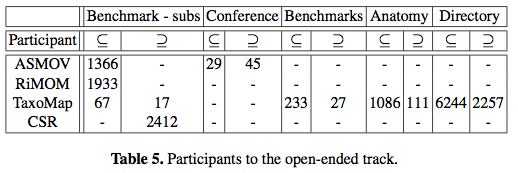
Authors: George Vouros (georgev ## aegean :: gr), Vassilis Spiliopoulos (vspiliop ## aegean :: gr), University of the Aegean Greece
Table 1. Results of all systems when applied to dataset 1
|
System |
CSR |
ASMOV |
RiMoM |
TaxoMap |
||||||||
|
Test |
Prec. |
Rec. |
F-m. |
Prec. |
Rec. |
F-m. |
Prec. |
Rec. |
F-m. |
Prec. |
Rec. |
F-m. |
|
1xx |
0.97 |
0.97 |
0.97 |
1.0 |
1.0 |
1.0 |
1.0 |
1.0 |
1.0 |
NaN |
0 |
NaN |
|
2xx |
0.84 |
0.78 |
0.80 |
0.94 |
0.94 |
0.94 |
0.67 |
0.85 |
0.69 |
0.84 |
0.08 |
0.25 |
|
3xx |
0.66 |
0.72 |
0.69 |
0.86 |
0.60 |
0.83 |
0.59 |
0.81 |
0.64 |
0.72 |
0.11 |
0.17 |
|
Average |
0.83 |
0.79 |
0.80 |
0.94 |
0.90 |
0.93 |
0.69 |
0.86 |
0.71 |
0.63 |
0.07 |
0.23 |
Table 1 presents the average precision, recall and f-measure values, of each participating system in all tests (Average) and separately in each test category (e.g. 1xx). We observe that in terms of f-measure ASMOV achieves the best results, followed by CSR, RiMoM and then by TaxoMap. Also, we observe that although CSR has a higher precision than RiMoM, RiMoM has a higher recall. As already commented, it would be interesting to see if and how the systems exploit equivalences (known or inferred) in order to locate subsumption ones. At this time we can report only for CSR, which does not exploit equivalence mappings.
Table 2. Results of CSR when applied to dataset 2
|
|
Precision |
Recall |
|
Iasted-Cmt |
0.37 |
0.67 |
|
Cmt-confOf |
0.35 |
0.83 |
|
Cmt-Confious |
0.25 |
0.33 |
|
confOf-Confious |
0.14 |
0.18 |
|
crs_dr-Confious |
0.00 |
0.00 |
|
Iasted-Confious |
0.08 |
0.28 |
|
OpenConf-Confious |
0.19 |
0.38 |
|
Pcs-Confious |
0.25 |
0.38 |
|
Cmt-crs_dr |
0.33 |
0.36 |
|
confOf-crs_dr |
0.00 |
0.00 |
|
confOf-Iasted |
0.48 |
0.41 |
|
crs_dr-Iasted |
0.18 |
0.39 |
|
OpenConf-Iasted |
0.14 |
0.38 |
|
PcsIasted |
0.22 |
0.38 |
|
Cmt-OpenConf |
0.43 |
0.43 |
|
confOf-OpenConf |
0.32 |
0.38 |
|
crs_dr-OpenConf |
0.12 |
0.21 |
|
Cmt-Pcs |
0.50 |
0.79 |
|
confOf-Pcs |
0.10 |
0.12 |
|
crs_dr-Pcs |
0.34 |
0.69 |
|
OpenConf-Pcs |
0.09 |
0.21 |
|
Cmt-Sigkdd |
0.54 |
0.75 |
|
confOf-Sigkdd |
0.08 |
0.31 |
|
Confious-Sigkdd |
0.29 |
0.38 |
|
crs_dr-Sigkdd |
0.00 |
0.00 |
|
Iasted-Sigkdd |
0.15 |
0.82 |
|
OpenConf-Sigkdd |
0.33 |
0.39 |
|
Pcs-Sigkdd |
0.24 |
0.43 |
|
Cmt-Conference |
0.26 |
0.11 |
|
confOf-Conference |
0.47 |
0.29 |
|
Confious-Conference |
0.16 |
0.33 |
|
crs_dr-Conference |
0.33 |
0.40 |
|
Iasted-Conference |
0.25 |
0.10 |
|
OpenConf-Conference |
0.11 |
0.10 |
|
Pcs-Conference |
0.11 |
0.10 |
|
Sigkdd-Conference |
0.22 |
0.18 |
|
Cmt-ekaw |
0.56 |
0.70 |
|
confOf-ekaw |
0.57 |
0.72 |
|
Confious-ekaw |
0.37 |
0.67 |
|
crs_dr-ekaw |
0.26 |
0.20 |
|
Iasted-ekaw |
0.52 |
0.48 |
|
OpenConf-ekaw |
0.31 |
0.28 |
|
Pcs-ekaw |
0.37 |
0.67 |
|
Sigkdd-ekaw |
0.68 |
0.76 |
|
Conference-ekaw |
0.53 |
0.63 |
|
Average |
0.28 |
0.39 |
Concerning dataset 2 table 2 depicts the precision and recall values for each pair of ontologies in the dataset provided by CSR. An observation is that the performance of CSR is worst in this dataset, in comparison to the first dataset.
[1] Ontology Alignment Evaluation Initiative 2006,
http://oaei.ontologymatching.org/2006/.
[2] Consensus Workshop Track, OAEI 2006,
http://oaei.ontologymatching.org/2006/conference/.
[3] O. Svab, V. Svatek, P. Berka, D. Rak, P. Tomasek, OntoFarm: Towards
an Experimental Collection of Parallel Ontologies, Poster Track of
ISWC, Galway, Ireland (2005).
